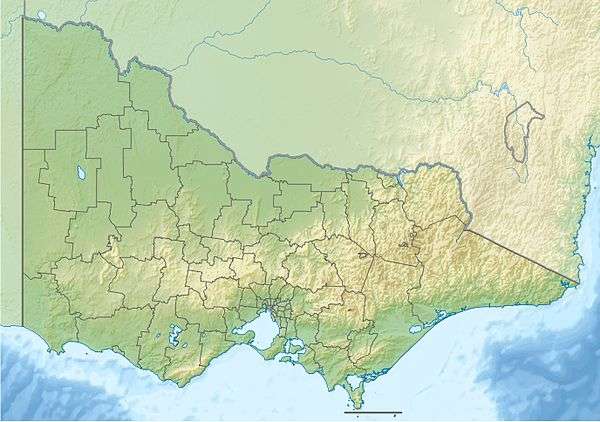Mount Wellington (Victoria)
| Mount Wellington | |
|---|---|
| Highest point | |
| Elevation | 1,634 metres (5,361 ft) AHD [1] |
| Coordinates | 37°30′29″S 146°50′47″E / 37.50806°S 146.84639°ECoordinates: 37°30′29″S 146°50′47″E / 37.50806°S 146.84639°E [2] |
| Geography | |
| Location | Victoria, Australia |
| Parent range | Great Dividing Range |
Mount Wellington is a mountain located to the north-east of Licola in Victoria, Australia.[2] It is on the border of the Alpine National Park and Avon Wilderness Park.[3] The Avon River rises on its south-eastern slopes.[3]
The mountain is accessible via a seasonally-open four-wheel drive track that traverses the ridge line. Features along the track include Millers Hut (originally built in 1916[4]), Taylors Lookout, The Sentinels, and Gable End. To the near west lies Lake Tali Karng.[3]
Mount Wellington was named by Angus McMillan, who was also the first European to ascend the mountain.[5] In November 1854, Victorian Government Botanist Ferdinand von Mueller climbed the mountain on the third of his three expeditions to the Victorian Alps, collecting a large number of plants, including Alpine Wattle, Dwarf Buttercup and Lilac Berry.[6][7][8][9]
See also
References
- ↑ Map No.T8222-1-4-1 Topographic Map (Map). Vicmap.
- 1 2 "Place Names Search: Mount Wellington". Geoscience Australia. Retrieved 21 January 2012.
- 1 2 3 "Alpine National Park" (PDF). Retrieved 21 January 2011.
- ↑ "Millers Hut". Kosciuszko Huts Association. Retrieved 21 January 2011.
- ↑ Mueller, Ferdinand. Definitions of Rare or Hitherto Undescribed Australian Plants; Chiefly Collected Within the Boundaries of the Colony of Victoria. p. 22.
- ↑ "Acacia alpina F.Muell.". Australian Plant Name Index (APNI), IBIS database. Centre for Plant Biodiversity Research, Australian Government.
- ↑ "Ranunculus millanii F.Muell.". Australian Plant Name Index (APNI), IBIS database. Centre for Plant Biodiversity Research, Australian Government.
- ↑ "Decaspora clarkei F.Muell.". Australian Plant Name Index (APNI), IBIS database. Centre for Plant Biodiversity Research, Australian Government.
- ↑ Slattery, Deirdre (1998). The Australian Alps: Kosciuszko, Alpine and Namadgi National Parks. Sydney: University of New South Wales Press. p. 107. ISBN 0-86840-319-9.
